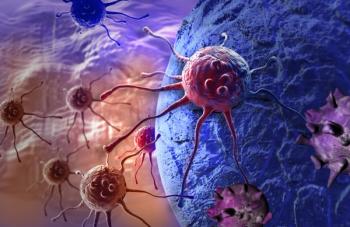
- ONCOLOGY Nurse Edition Vol 25 No 2
- Volume 25
- Issue 2
Falls Are Key in Patient Assessment and Planning
Falls and the risk of falls are critical health concerns that can impact cancer treatment and recovery. In 2007, the Centers for Disease Control (CDC) reported that more than 18,000 older adults in the United States died from injuries sustained from falls (CDC, 2010).[1] Older people diagnosed with a malignancy and who are undergoing cancer treatment using chemotherapy have an increased risk of falls.[2]
Falls and the risk of falls are critical health concerns that can impact cancer treatment and recovery. In 2007, the Centers for Disease Control (CDC) reported that more than 18,000 older adults in the United States died from injuries sustained from falls (CDC, 2010).[1] Older people diagnosed with a malignancy and who are undergoing cancer treatment using chemotherapy have an increased risk of falls.[2] Injury from falls can potentially delay cancer treatment and reduce the quality of life of older cancer patients, therefore it is important that clinical oncology nurses assess and implement fall-education programs for patients and families. The article by Davis and Kline is an important contribution to evidenced-based nursing practice issues specific to falls in cancer patients.
The authors consider a point central to the issue of a conducting a fall assessment, in that creating an assessment instrument will not reduce falls or injury from falls. Actually, assessment of falls is rather easy; development of an intervention strategy can be very difficult. Fall risk–assessment has generally been conducted using the American Geriatrics Society standard assessment item of “Have you fallen in the past year?"[3] People who have fallen in the past year are more likely to experience another fall.[4] Simply assessing if a fall has occurred and asking about the specific events causing the fall can lead to an individualized intervention strategy. Of note, an earlier study focused on personal accounts of the situations causing a fall. No real patterns or consistent themes emerged from the data, in that all the situations were different, so it is necessary to individually assess reasons that a fall occurred.[5] Using a standard instrument to assess risk may miss some of the individual circumstances that should be addressed to minimize the opportunity for another fall.
The Inpatient Falls Safety Program is an exciting option for management of falls in cancer patients. The significant decrease in falls after participation in the Falls Safety Program is the evidence needed to create and implement fall safety programs in cancer centers around the country. Inpatient education is reasonable in that the patient and family are available. An educational offering can be made prior to discharge as opposed to asking a patient and family to return to the hospital. Also, people who are admitted to a cancer center may be more ill or recovering from surgery, which may account for additional risks compared with those of people who are receiving outpatient cancer care.
Providing patients and families data on some of the known general circumstances associated with falling can be helpful in potentially reducing falls. Some of the known factors that should be included in fall educational programs are:
• bathrooms are high-risk places for falls;
• people who have visual limitations are at greater risk of falls;
• people who have functional problems are at greater risk of falls; and
• people who have experienced a previous fall are at greater risk of falls.
Motivating patients and families to consider safety factors should a fall occur must be part of the outpatient oncology nursing discharge process. Issues such as not locking the bathroom door when bathing, or bringing a phone and placing it on the bathroom floor when bathing may help to reduce injury resulting from the inability to receive timely assistance after a fall. Also, consider potential weakness and fatigue resulting from chemotherapy. Perhaps on days immediately following chemotherapy, bathing should be avoided or another individual should be in the home at the time of bathing. Anticipating common treatment factors such as weakness and fatigue may help to further reduce injury from falls.
Development of an individualized intervention strategy is a critical component of oncology nursing care, as addressed by the authors. Fall assessment must lead to intervention strategies, otherwise the evaluation is essentially useless. Intervention strategies must be practical and accepted by the patient and family. Follow-up in the ambulatory care setting is also critical to reducing falls. Electronically flagging the patient information may be the catalyst for continued nursing assessment and a dynamic intervention strategy.
Oncology nurses must recognize that falls and injury from falls constitute a considerable risk factor in the care of the older cancer patient. Problems associated with anemia,[6] fatigue,[7,8] weakness,[9] and other issues associated with treatment toxicity can be prime motivators for a fall. Fall assessment should be part of the admission process and discharge plan in every cancer center in the United States. The authors have performed an excellent job in development of an effective assessment-and-intervention strategy for identification and reduction of falls in the older cancer patient.
References:
References
1.
Centers for Disease Control and Prevention, National Center for Injury Prevention and Control: Web-based Injury Statistics Query and Reporting System (WISQARS). Available at:
http://www.cdc.gov
. Page last updated on March 4, 2010. Accessed on January 16, 2011.
2.
Overcash JA, Beckstead J: Predicting falls in older patients using components of a comprehensive geriatric assessment.
Clin J Oncol
Nurs 12(6):941â949, 2008.
3.
The American Geriatrics Society/British Geriatrics Society Clinical Practice Guideline: Prevention of Falls in Older Persons. Available at:
http://www.americangeriatrics.org
. Accessed on January 16, 2011.
4.
Guideline for the prevention of falls in older persons. American Geriatrics Society, British Geriatrics Society, and American Academy of Orthopaedic Surgeons Panel on Falls Prevention.
J Am Geriatr Soc
49(5):664â672, 2001.
5.
Overcash JA, Rivera HR, Van Schaick J: An analysis of falls experienced by older adult patients diagnosed with cancer.
Oncol Nurs Forum
37(5):573â580, 2010.
6.
Holley S: A look at the problem of falls among people with cancer.
Clin J Oncol Nurs
6(4):193â197, 2002.
7.
Mock V: Evidence-based treatment for cancer-related fatigue.
J Natl Cancer Inst Monogr
(32):112â118, 2004.
8.
Nail LM, Winningham ML: Fatigue and weakness in cancer patients: The symptoms experience.
Semin Oncol Nurs
11(4):272â278, 1995.
9.
O'Connell B, Cockayne M, Wellman D, et al: Fall risk factors and the nature of falls in inpatient oncology and palliative care settings.
Contemp Nurse
18(3):247â257, 2005.
Articles in this issue
almost 15 years ago
Four-Gene Signature Predicts Aggressive Prostate Canceralmost 15 years ago
Eribulin, a Microtubule Inhibitor for Metastatic Breast Canceralmost 15 years ago
ONCOLOGY Nurse Edition Continuing Medical Education February 2011almost 15 years ago
Evolution and Opportunityalmost 15 years ago
Fall Risk Assessment and Preventionalmost 15 years ago
Counseling High-Risk Women About Breast Canceralmost 15 years ago
Care of the Older Adult With Canceralmost 15 years ago
YogaNewsletter
Stay up to date on recent advances in the multidisciplinary approach to cancer.

















































































